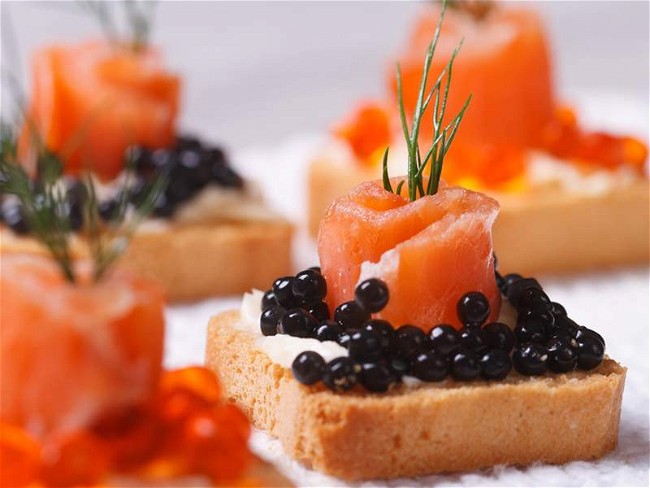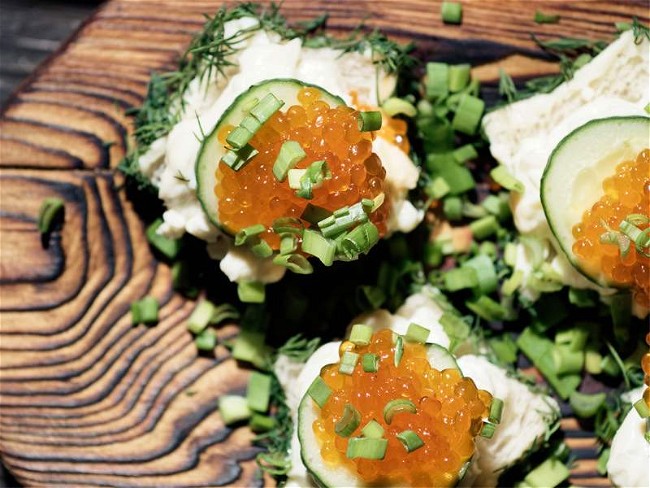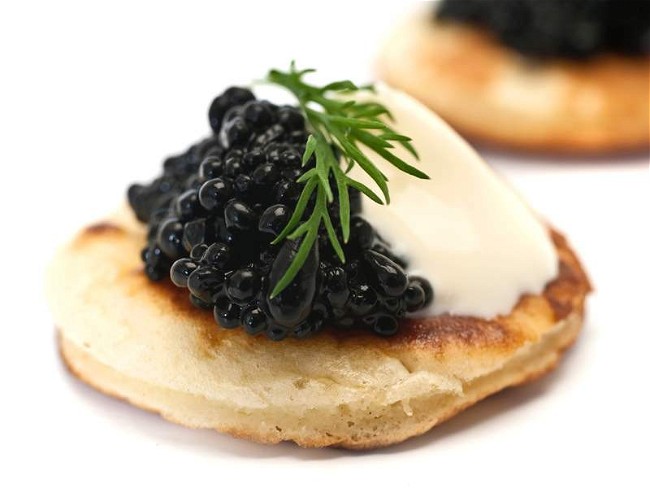Your Essential Guide to Caviar

Caviar, often synonymous with luxury and sophistication, has a rich and storied history. Caviar’s popularity dates back to the 4th century B.C. when Aristotle himself first wrote about cured sturgeon eggs. It wasn’t until the 19th century A.D. that caviar permanently staked its claim on royal dinner plates. Centuries before it became a symbol of opulence, caviar was a staple food for sturgeon fishermen along the Caspian and Black Sea coasts near today’s Russia. To eat cheaply at sea, the fishermen would salt cure and eat sturgeon eggs that would otherwise be discarded. These cured eggs, which we now call caviar, caught the attention of Russian and Persian nobility, who began to prize it as a delicacy and brought it to the tables of European aristocracy in the 1800s, where caviar cemented its status as a gourmet food.
Today, caviar continues to be celebrated for its exquisite taste and luxurious appeal. Whether you’re a caviar connoisseur or simply curious about this storied seafood, this comprehensive guide will share all you need to learn about and confidently serve caviar at your next dinner party.
- What is Caviar?
- Caviar vs. Roe: What’s the Difference?
- What Does Caviar Taste Like?
- Types of Caviar
- Why is Caviar So Expensive?
- How Do I Serve Caviar?
What is Caviar?
Caviar is the name for salt-cured fish eggs, or roe. The definition of caviar has widened from exclusively cured eggs of sturgeon in the Caspian or Black Sea to include the preserved eggs of any sturgeon species regardless of origin, sturgeon relatives like paddlefish, and more recently various other fish like salmon and trout. This expansion is partially a result of sturgeon caviar’s globally growing demand amid scarcity, prompting the market to explore alternatives.
Caviar vs. Roe: What’s the Difference?
In its most formal definition, caviar refers to the eggs from a sturgeon species, sourced primarily from the Caspian or Black Sea and lightly cured in salt. Roe, on the other hand, encompasses the eggs of any fish or shellfish, regardless of preparation. Over time, the distinction between caviar and roe has blurred, as many non-sturgeon fish eggs are now commonly referred to as caviar worldwide. This has prompted sturgeon caviar to occasionally be called “true caviar.”
What Does Caviar Taste Like?
Generally, caviar has delightfully buttery and slightly briny flavors, while the texture varies from smooth and creamy to bold and crunchy depending on factors like species and quality.
Caviar’s flavor profile is a symphony of nuanced tastes and textures, making it a unique culinary experience. Caviar is known for its delicate balance of briny and buttery flavors, often accompanied by a subtle hint of sweetness or nuttiness. Caviar’s taste and texture can vary significantly depending on the type of fish, the quality of the roe, and the processing methods used.
Types of Caviar
With countless caviar species options out there, finding your own favorite caviar can be a deliciously daunting task. Crowning “the best” caviar is entirely up to your taste buds, so we recommend trying a few different kinds in one sitting to compare and help you find your favorite. Let’s explore the most popular caviars:
Sturgeon caviar is often considered the gold standard in taste, prized for its rich, creamy texture and complex flavor profiles. The taste of sturgeon caviar is thought to be significantly influenced by the sturgeon’s diet of crustaceans and small fish, imparting richness and complexity in their eggs.

Beluga caviar boasts large, pearlescent eggs that deliver a lavishly buttery taste with a delicate, nutty finish. The Beluga sturgeon, native to the Caspian Sea, is one of the largest and oldest known sturgeon species, capable of living over 100 years. Due to its rarity and the lengthy time it takes Beluga sturgeon to mature, Beluga caviar is the most expensive and highly sought after, often considered the pinnacle of luxury in the culinary world, ideal for lavish events.

Osetra caviar, also spelled Ossetra, is one of the most prized types of true caviar, second only to Beluga. Osetra caviar is slightly smaller than Beluga, with just as nutty and rich flavors. Each golden-brown egg brings a balanced firmness that caviar lovers adore. Osetra caviar is harvested from the Osetra sturgeon, which can weigh up to 400 pounds and live up to 50 years. This moderately expensive caviar is a terrific option for a romantic dinner or small gathering.
- Kaluga caviar comes from the Kaluga sturgeon, a species native to the Amur River basin. This caviar is known for its large, dark gray to black eggs and rich, buttery flavor with a smooth finish. Often compared to Beluga caviar, Kaluga caviar is highly beloved for its luxurious taste and melt-in-your-mouth texture. One of the more expensive caviars, Kaluga caviar is commonly found at holiday parties.
- Sevruga caviar is harvested from the Sevruga sturgeon, a smaller sturgeon species. Native to the Caspian, Black, and Aegean Sea basins, the Sevruga sturgeon produces small, pearlescent gray eggs. Sevruga caviar is known for its strong, bold flavor with a slightly salty taste. With a relatively approachable price tag for a true caviar and milder flavor profile, Sevruga caviar is a popular choice for those new to caviar and aficionados alike.

White Sturgeon caviar is celebrated for its delicate flavor and smooth texture. The White Sturgeon, native to America’s Pacific Northwest, can live up to 100 years and produces medium-sized, glossy black eggs with a creamy mouthfeel and a hint of ocean brine. This modestly priced caviar is highly regarded for its versatility in culinary applications, making it perfect for sharing generous portions at a dinner party.

Hackleback caviar is sourced from the Hackleback, or Shovelnose, sturgeon, the smallest sturgeon species native to America’s Missouri and Mississippi rivers. This caviar is characterized by its small, jet-black eggs and mildly rich flavor. Known for its firm texture and subtle taste, Hackleback caviar is a unique and popular domestic option at an approachable price point, suitable for adding flare to any occasion.

Hybrid caviars are made from specially cross-breeding certain sturgeon species, resulting in a product that offers a balance of flavors and textures. These hybrid caviars have grown in popularity due to their truly unique flavors and lesser import restrictions than pure Beluga caviar in the US. The most cherished hybrid caviar is Beluga Hybrid caviar, which combines the treasured creaminess of Beluga caviar with the firmness of other sturgeon caviars like Sevruga or Kaluga. Almost as popular is the Kaluga Hybrid caviar made from the cross-breeding of Kaluga and Amur sturgeon species. This results in large, gray-to-black eggs that have refined umami (savory) flavors and a fresh finish. Hybrid caviars vary in price points while staying versatile for fancy and casual occasions alike.
Non-sturgeon caviars, while not “true caviar” by definition, these various fish roe can bring a wide spectrum of flavors, textures, and colors to your plate.

Paddlefish caviar comes from the American Paddlefish, a close relative of the sturgeon. Paddlefish caviar boasts a medium-sized, dark gray to black appearance, holding mildly earthy flavors inside each egg. Paddlefish caviar is sure to delight a crowd and is more widely available than many imported sturgeon caviars as a wonderful domestic treat.

Salmon roe, also referred to as red caviar, are salt-cured eggs from various salmon species. The roe from pink salmon, the most common wild salmon caviar, features medium-sized, vibrant orange eggs with a milder flavor and subtle sweetness. Atlantic salmon roe, the most popular farmed salmon caviar, boasts large, bright orange eggs with a robust, briny taste and firm texture. Keta salmon caviar, also known as ikura, is especially cherished in Japanese cuisine. Ikura is revered for its large, deep orange eggs and rich, briny flavor with a slightly sweet finish. Each type provides a distinct tasting experience, making salmon roe a fantastic garnish for nearly any savory dish and a crowd-pleaser at large gatherings.

Trout roe is typically harvested from freshwater trout species, making it less briny than salmon roe and bringing just a hint of sweetness. The mild profile and golden color of trout caviar is quite versatile and accessible, offering a relatively affordable luxury dining experience that’s also suitable for larger groups.
- Tobiko, or masago, is the caviar of flying fish. Tobiko is a staple in Japanese food, especially sushi, on which you may have seen tiny pearls that bring a crunchy pop to each bite. Tobiko is naturally light orange and carries light citrus flavors. However, it is very common to see this caviar in numerous other colors from infusing it with other ingredients. Green tobiko is infused with wasabi flavoring to add spice and its unmistakable hue, while yellow tobiko doubles down on citrus notes by infusing lemon or yuzu into the eggs. Black tobiko is brined with squid ink, giving it a striking visual resemblance to some sturgeon caviars. Its intense brine and crunchier texture clearly distinguish it from true sturgeon caviar for anyone who’s tried both. Tobiko is very affordable compared to its other caviar cousins.
What Color is Caviar?
Caviar comes in an impressive variety of colors, which can hint at the caviar's origin, diet, and overall quality. Traditional sturgeon caviar ranges from deep black to dark gray, with Beluga caviar often presenting a pearly, almost metallic sheen. Golden hues are seen in the rare Albino sturgeon caviar, a true symbol of luxury and exclusivity with a matching price tag. Non-sturgeon roe, like salmon and trout, contributes vibrant shades of orange and red, while tobiko (flying fish roe) is often bright orange and can be infused with other colors like green, yellow, and black. The environment in which the fish are raised, including their diet and habitat, plays a significant role in determining the color of their eggs.
How is Caviar Made?
Historically, caviar was harvested only by killing fish and extracting their roe to preserve with sea salt, then grading and packaging it. However, modern methods of harvesting caviar often use no-kill techniques that enable a fish to live longer. These methods include massaging the fish to release the eggs or performing a simple surgery to extract the roe, allowing the fish to recover, extend its lifespan, and produce more eggs in the future. After extraction, the eggs are then meticulously cleaned, salted, and graded based on size, color, and texture before being packaged for sale as caviar.
Is Caviar Sustainable?
Caviar can indeed be produced sustainably, ensuring your lavish eats are balanced with environmental responsibility. Nowadays, you will find far more caviar from domestically farmed sturgeon than wild fish, alleviating pressure on endangered wild sturgeon stocks in key waters like the Caspian and Black Seas. These modern, sustainable, and humane practices also make caviar more affordable by allowing each fish to produce more roe without harming species populations. Certain types of caviar, particularly those sourced from endangered sturgeon species in Russia, are unsustainable and contribute to the depletion of wild populations.
Sustainable caviar farming involves careful management of water quality, feed, and breeding practices to ensure minimal environmental impact. At Fulton Fish Market, we're proud to source our caviar exclusively from the most sustainable and highest-quality producers, ensuring that our products support the conservation of wild sturgeon populations and promote ethical aquaculture practices.
When is Caviar In Season?
Caviar can be enjoyed at peak freshness year-round. Since most sturgeon and non-sturgeon caviar are sourced from farmed fish and properly stored and handled, caviar has a shelf life of several months. There generally isn’t a "peak season" for the best sturgeon caviar. Caviar from predominantly wild fish, such as pink salmon and keta salmon, are most widely available and best enjoyed around the spawning season of late summer through early autumn. Most caviar industrially freezes exceptionally well due to its high-fat content, stable structure, and salting process, ensuring it remains delectable and readily available throughout the year.
How is Caviar Graded?
Caviar is meticulously graded based on several key factors: egg size, color, texture, and flavor. The highest quality caviar, often labeled as “Grade 1,” features large, firm eggs with a consistent color and a delicate, buttery flavor. Lower grades may have smaller, softer eggs with less uniformity in color and a more pronounced briny taste. This grading system ensures that consumers can select caviar that meets their specific preferences and quality expectations.
Why is Caviar So Expensive?
Caviar isn’t just expensive for its rich, royal history. True caviar can fetch upwards of $1,000 per ounce because of the lengthy maturation period required for sturgeon to produce roe, often taking over a decade. Additionally, the labor-intensive harvesting and processing methods, coupled with strict regulations and conservation efforts to protect endangered sturgeon species, even further limit supply. These factors, plus the meticulous grading and quality control processes, contribute to caviar’s price tag.
How Do I Store Caviar?
Keep your caviar sealed and refrigerated at a temperature between 32-36°F (0-2°C) to maintain its quality. Once opened, cover the remaining caviar with plastic wrap, gently pressing it to remove any air, place the lid back on the tin or jar, and store it in the coldest part of your refrigerator to enjoy its exquisite taste for up to three days.
How Do I Prepare Caviar?
The delights of caviar don’t stop at its stunning looks and unforgettable flavors. Another wonder of caviar is that you do not have to cook it to enjoy it. Caviar should only be eaten raw, as cooking degrades the taste and textures that make it so tasty. The only necessary preparation for a fantastic caviar experience is storing it in your refrigerator to keep it cold until you serve it. Once opened, caviar should be consumed within a few days to enjoy it at peak freshness and quality.
How Do I Serve Caviar?
Serving caviar starts with proper storage, so be sure to keep it chilled from delivery all the way through serving it. Tins of caviar are commonly served directly on a bed of crushed ice or a chilled plate to keep an optimal temperature while giving the caviar the beautiful presentation it deserves.
When serving caviar, it’s crucial to use non-metallic utensils and dishes to avoid any metallic taste that can alter the caviar’s flavor. Traditional materials include mother-of-pearl, bone, glass, or even plastic. For a truly luxurious experience, gold utensils can be used, as gold does not react with the caviar.
How Do I Eat Caviar?
While indulging in caviar right from the spoon is an incredible tasting experience of its own, you can easily enhance your caviar experience by accompanying it with any combination of the following caviar co-stars:
- Blinis: Small, fluffy pancakes that provide a neutral base for the caviar.
- Crème Fraîche: Adds a creamy texture that pairs well with caviar’s briny notes.
- Toast Points: Thinly sliced, lightly buttered toast that offers a crunchy contrast to the delicateness of caviar.
- Minced Onions: Adds a bit of sharpness to balance the caviar’s richness.
- Lemon Wedges: A squeeze of lemon can enhance the caviar’s flavor, also balancing its richness.
- Vanilla Ice Cream: If you’re feeling adventurous or just have a sweet tooth, this pairing is for you. The creamy sweetness of the ice cream beautifully complements the briny, rich flavors of the caviar, creating an unforgettable taste experience.
When enjoying caviar without accompaniments, it’s best to let it rest on your tongue and gently press it against the roof of your mouth. This allows the delicate roe to burst and slowly release its full flavor. Chewing caviar can diminish its subtle, nuanced taste, so savoring it slowly enhances the luxurious experience.
A newly coined method of eating caviar, “caviar bumps,” makes for an exciting twist on the classic caviar experience. Caviar bumps involve placing a small spoonful of caviar on the back of your hand, typically below your thumb, and then directly savoring the flavors in one slurp—making for a unique and indulgent taste sensation.
How Much is a Serving of Caviar?
The typical serving size for caviar is a half ounce, about a tablespoon, per person. If mixing other appetizers or dishes into your menu, a quarter-ounce serving is sufficient.
Is Caviar Kosher?
True sturgeon caviar is not kosher due to the sturgeon’s lack of scales and specific blessings required for kosher certifications. Non-sturgeon caviars, like salmon caviar, for example, can indeed be kosher.
Is Caviar Healthy?
Caviar is packed with nutrients, including high-quality protein, omega-3 fatty acids, vitamins, and minerals. Caviar can be a very nutritious addition to a balanced diet.
Caviar Recipes
Are you ready to impress your dinner guests or simply treat yourself? Check out these caviar recipes that showcase versatility and elegance, which are sure to wow any crowd.
Caviar & Smoked Salmon Canapés Recipe
Here’s a stunning appetizer that will leave a lasting impression on your dinner guests. Sure, the preparation is simple, but the flavors aren’t – smoked salmon, rich cheeses, and decadent caviar meld into one blissful bite.
Caviar & Cucumber Sandwiches Recipe
These one-bite appetizers fall under the “easy appetizers” category. You’ll save yourself cooking time and a load of dishes, which means more time to mingle with your dinner guests and enjoy that bubbly.
Blinis with Black Caviar Recipe
This simple recipe for blinis and caviar is a holiday favorite. Top these one-bite wonders with our stunning assortment of caviars, a dollop of crème fraîche, and a sprig of fresh dill or chives. They’re that easy to prepare.



